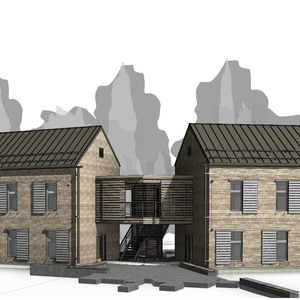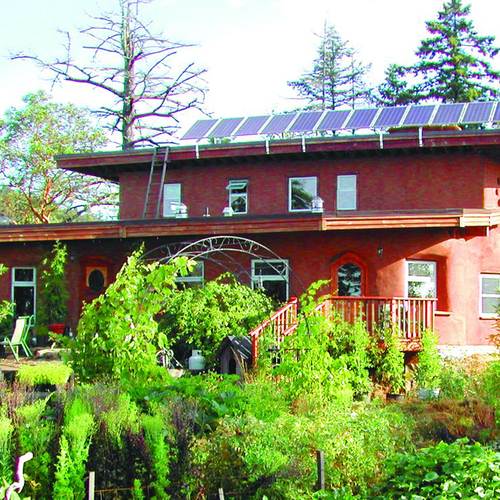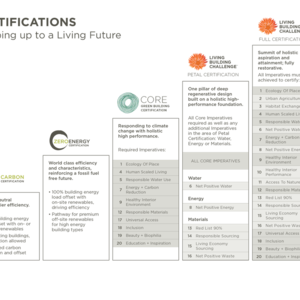
Shelby Aldrich and her husband, William, are pursuing Living Building Challenge (LBC) certification for their home in rural Pennsylvania. While undertaking this commitment to build a regenerative house made of healthy materials, Shelby has become an advocate, inspiring manufacturers to seek Declare labels, leading to more products relevant to LBC projects. To help streamline her advocacy and transparency efforts, Shelby created resources she has made available to the public.
How do you see material health and transparency affecting people’s everyday lives?
When I was in elementary school, we had a program that came and spoke to us about chemicals, and how there were certain products that our parents probably had in our homes that we should not touch. Cleaning agents, mostly. They gave us green stickers with a “yucky” face on them and tasked us with going around our homes with our parents and sticking those stickers on anything that we shouldn’t be touching.
This activity prompted me to ask, “How do we know what is, and isn’t, good for us?” My parents told me that, in general, people wouldn’t manufacture products that are bad for us. And if they do, the product comes with warnings and must follow certain rules by the government.
I upheld this benefit of trust that our well-being is the primary objective of manufacturers and governments for a long time. Because, why wouldn’t I? However, as I am now delving into the Materials Petal for our home for our future children, I am quickly learning that the manufacturing industry heavily relies on the mentality that “it is good until it can be proven bad” rather than “it is bad until it can be proven good”…especially in terms of the whole lifecycle of a product. Just because it is “good” in one phase of its life, does not mean it isn’t “bad” in another.
We don’t want to fill our homes with products our children have to run around and stick “yucky” faces on everything. No one does. But at this given time, most of the pressure rests on consumers to be educated buyers, rather than on the manufacturers to take into consideration their product’s health at every phase of its life, and then be honest and open to consumers on what their products contain.
Declare labels are a great way to make responsibility rest equally on both the manufacturer and consumer. They do a great job of putting the health of a product onto a singular page in an easy-to-read format.
What made you decide to pursue the Living Building Challenge for your home?
William and I were initially drawn to Passive House when we were designing our home. It was a standard of building that just made sense, and William even went on to become a Certified Passive House Consultant so that he could be the CPHC on our own project. When we learned of the Living Building Challenge (LBC), we were enthralled by how it elevated sustainable building to a regenerative framework that was actively being applied by folks. We wanted in.
The part that most drew us to the LBC was the concept that our home should give back to the ecosystem it becomes a part of. We both grew up in a rural county, very much in the middle of the woods. When we sought sites to build, we knew we wanted to raise our children in the woods as well. However, we wanted to build our home in a way that was minimally intrusive to the site. The LBC creates a framework in which we can actively strive to achieve a home that gives back more than it takes away from the land it becomes a part of.
Your advocacy efforts led directly to three different manufacturers obtaining their first Declare labels. What about their products spoke to you?
Steller Floors
Based in Pennsylvania, their wood floors are made in a way that no adhesives are used in the installation process. Instead, they use clips, which allow the floorboards to be easily removed at their end of life and repurposed. They come with Forest Stewardship Council (FSC) certification. While their fastener system is PVC, they have expressed efforts to change to a Red List Free alternative.
Bingaman Lumber’s Thermally Modified Wood
Their manufacturing plant is less than an hour’s drive away, right up the Susquehanna River (we went to visit). We intend to use their thermally modified wood—which contains no chemicals—as exterior siding and for our deck. Their wood is mostly obtained from FSC forests in Pennsylvania and New York.
GoliathTech Helical Piles
Using piles as our foundation allows us to keep the native soils and tree root systems more intact on our site. The helical pile foundation also will not impede stormwater flows, and it doesn’t use concrete.
Can you tell us a little about your advocacy process?
I don’t think manufacturers want their children running around putting “yucky” face stickers all over products in their own homes, either. And I try to remember that as I pursue the advocacy process.
When we are really excited about a product, we become invested in making it possible to use that product in our home. I make sure to tell the manufacturer why we are so excited about their product and why I think their product is such a good fit for our project, highlighting all the good they are already doing as a manufacturer.
Then I ask them if they can do more.
I ask for Health Product Declarations (HPD) or Safety Data Sheets (SDS). If they have them, but they don’t disclose enough, I ask if they can provide more info. If they don’t have HPDs or an SDS, I offer a Manufacturer Inquiry Document for them to fill out. I advocate for Declare, expressing that if we need their product in our project, other project teams could as well (and Declare just makes specifying so much easier). It is a long process. There are a lot of conversations going back and forth. Staying patient—but firm—on requirements is of course, important. It can get frustrating, but I know that my “asks” can be frustrating to them, too.
When a product seems like it is not going to work out, or even when I receive a very blatant “not worth our time,” I try to remember that a seed has been planted. However small.
What value does having products with Declare labels in your home bring to you?
I see Declare labels like the anti-“yucky” face stickers. When our home is built, we can give our children “Declare” stickers and they can run around and stick them on the products that make up our home. And we, and our kids, will know exactly what our home is made from. I think there is a multi-generational value in that.
Weekly Newsletter
Get building science and energy efficiency advice, plus special offers, in your inbox.














0 Comments
Log in or create an account to post a comment.
Sign up Log in